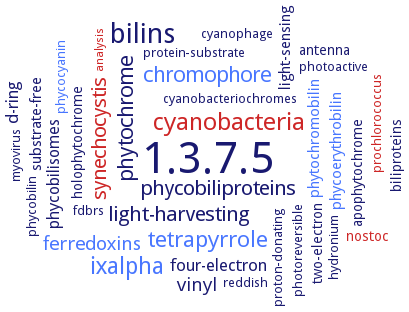1.3.7.5: phycocyanobilin:ferredoxin oxidoreductase
This is an abbreviated version!
For detailed information about phycocyanobilin:ferredoxin oxidoreductase, go to the full flat file.

Word Map on EC 1.3.7.5 
-
1.3.7.5
-
bilins
-
cyanobacteria
-
ixalpha
-
tetrapyrrole
-
chromophore
-
phytochrome
-
light-harvesting
-
synechocystis
-
phycobiliproteins
-
ferredoxins
-
vinyl
-
four-electron
-
d-ring
-
phycobilisomes
-
phytochromobilin
-
substrate-free
-
phycoerythrobilin
-
light-sensing
-
biliproteins
-
antenna
-
holophytochrome
-
two-electron
-
nostoc
-
apophytochrome
-
cyanobacteriochromes
-
photoreversible
-
phycobilin
-
cyanophage
-
fdbrs
-
reddish
-
photoactive
-
phycocyanin
-
prochlorococcus
-
proton-donating
-
myovirus
-
protein-substrate
-
hydronium
-
analysis
- 1.3.7.5
-
bilins
- cyanobacteria
- ixalpha
- tetrapyrrole
- chromophore
-
phytochrome
-
light-harvesting
- synechocystis
-
phycobiliproteins
- ferredoxins
-
vinyl
-
four-electron
-
d-ring
-
phycobilisomes
- phytochromobilin
-
substrate-free
- phycoerythrobilin
-
light-sensing
-
biliproteins
-
antenna
-
holophytochrome
-
two-electron
- nostoc
-
apophytochrome
-
cyanobacteriochromes
-
photoreversible
-
phycobilin
-
cyanophage
-
fdbrs
-
reddish
-
photoactive
- phycocyanin
- prochlorococcus
-
proton-donating
-
myovirus
-
protein-substrate
-
hydronium
- analysis
Reaction
Synonyms
3Z-phycocyanobilin:ferredoxin oxidoreductase, AmPcyAc, AmPcyAp, bilin reductase, FDBR, ferredoxin-dependent biliverdin reductase, ferredoxin:3Z-phycocyanobilin oxidoreductase, HY2 protein, oxidoreductase, ferredoxin:3Z-phycocyanobilin, Pcb:Fd oxidoreductase, PCB:ferredoxin oxidoreductase, PcyA, PCYA1, phycocyanobilin synthase, phycocyanobilin-ferredoxin oxidoreductase, phycocyanobilin:ferredoxin oxidoreductase, SyPcyA
ECTree
Advanced search results
Engineering
Engineering on EC 1.3.7.5 - phycocyanobilin:ferredoxin oxidoreductase
Please wait a moment until all data is loaded. This message will disappear when all data is loaded.
D102N
D105N
E76Q
site-directed mutagenesis, substrate-binding structure compared to the wild-type enzyme. Overall folds and the binding sites of the U-shaped substrates of all three complexes are similar with wild-type PcyABV, the orientation of the Glu76 side chain, which is in close contact with the exo-vinyl group in PcyA-biliverdin IXalpha, is rotated away from the bilin D-ring. The local structures around the A-rings in the three complexes, which all retain the ability to reduce the A-ring of their bound pigments, are nearly identical with that of wild-type PcyA-biliverdin IXalpha
H88Q
V225D
site-directed mutagenesis,substrate binding structure, overview
I86D
biliverdin bound to the I86D mutant is fully protonated (BVH+) and can accept an electron, but I86D is unable to donate protons for the reduction. Compared to the wild-type PcyA, the I86D mutant stabilizes BVH+
additional information
D102N
high-field electron paramagnetic resonance spectroscopy of frozen solutions and single crystals of the one-electron reduced protein-substrate complex of mutant D102N. Spectra reveal a biliverdin radical with a very narrow g tensor. This g tensor is consistent with a biliverdin radical where the carbonyl oxygen atoms on both the A and the D pyrrole rings are protonated
D105N
high-field electron paramagnetic resonance spectroscopy of frozen solutions and single crystals of the one-electron reduced protein-substrate complex of mutant D105N. Spectra reveal a biliverdin radical with a very narrow g tensor with principal values 2.00359(5), 2.00341(5), and 2.00218(5). This g tensor is consistent with a biliverdin radical where the carbonyl oxygen atoms on both the A and the D pyrrole rings are protonated
H88Q
the g anisotropy of the biliverdin radical in H88Q is measurably smaller than those of mutant D105N
identification of mutant pcya1-1, cloning and photosynthetic phenotype analysis, overview. Efficient PCYA1 knockdown by artificial microRNA does not impact algal phototrophic growth. Yeast two-hybrid analyses of protein-protein interaction with bilin biosynthesis metabolism proteins using the coding regions of CrPCYA11TP (amino acids 56-556), CrPCYA1-NTE (amino acids 56-174), CrPCYA1-FDBR (amino acids 175-451), CrPCYA1-CTE (amino acids 449-556), and pull-down assay
additional information
-
identification of mutant pcya1-1, cloning and photosynthetic phenotype analysis, overview. Efficient PCYA1 knockdown by artificial microRNA does not impact algal phototrophic growth. Yeast two-hybrid analyses of protein-protein interaction with bilin biosynthesis metabolism proteins using the coding regions of CrPCYA11TP (amino acids 56-556), CrPCYA1-NTE (amino acids 56-174), CrPCYA1-FDBR (amino acids 175-451), CrPCYA1-CTE (amino acids 449-556), and pull-down assay
additional information
-
identification of mutant pcya1-1, cloning and photosynthetic phenotype analysis, overview. Efficient PCYA1 knockdown by artificial microRNA does not impact algal phototrophic growth. Yeast two-hybrid analyses of protein-protein interaction with bilin biosynthesis metabolism proteins using the coding regions of CrPCYA11TP (amino acids 56-556), CrPCYA1-NTE (amino acids 56-174), CrPCYA1-FDBR (amino acids 175-451), CrPCYA1-CTE (amino acids 449-556), and pull-down assay
-
additional information
-
insertional inactivation of pcyA is not possible in wild-type Synechococcus sp. strain PCC 7002 due to lethality of the mutant, but in a variant heterologously expressing HY2 from Arabidopsis thaliana encoding a phytochromobilin:ferredoxin oxidoreductase
additional information
-
insertional inactivation of pcyA is not possible in wild-type Synechococcus sp. strain PCC 7002 due to lethality of the mutant, but in a variant heterologously expressing HY2 from Arabidopsis thaliana encoding a phytochromobilin:ferredoxin oxidoreductase
-
additional information
construction of a plasmid containing genes of apo-allophycocyanin alpha-subunit without chromophore and chromophore synthetases HO1, i.e. ferredoxin-dependent heme oxygenase, and PcyA, i.e. phycocyanobilin:ferredoxin oxidoreductase, and expression in Escherichia coli. Holo-allophycocyanin, i.e. allophycocyanin alpha-subunit with chromophore, can be synthesized by autocatalysis in Escherichia coli. Recombinant holo-allophycocyanin alpha-subunit shows the same spectral and fluorescent properties as phycocyanin and serves as a good substitute for native phycocyanin for fluorescent tagging. Recombinant allophycocyanin alpha-subunit can inhibit hydroxyl and peroxyl radicals more strongly than holo-allophycocyanin alpha-subunit and native allophycocyanin


 results (
results ( results (
results ( top
top






